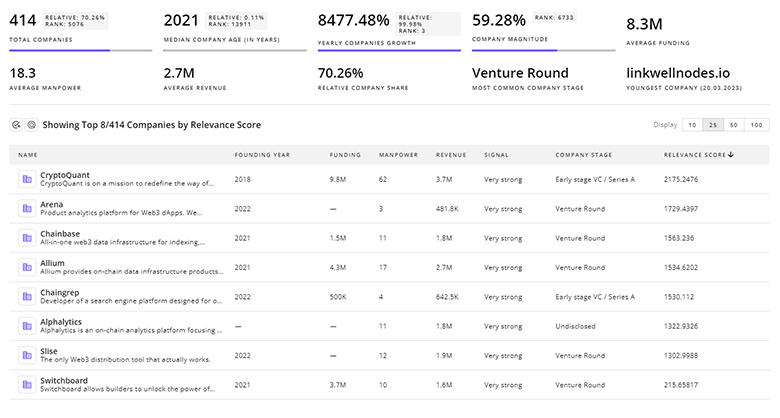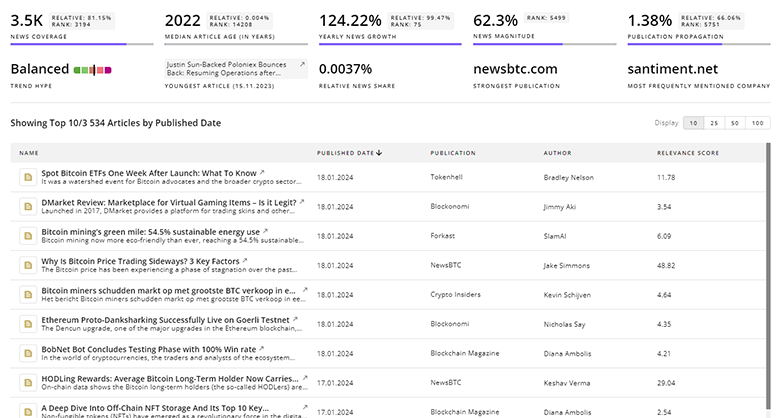
Health Care Diagnostics Report
: Analysis on the Market, Trends, and TechnologiesThe diagnostics market sits at an inflection where decentralization, AI, and multi-omic assays drive measurable commercial expansion: the internal health care diagnostics dataset reports a 2024 market size of USD 30,000,000,000 and a 7.5% CAGR to 2030, with a projected point-of-care segment reaching USD 46,400,000,000 by 2030. External benchmarking shows complementary signals: AI-enabled tools promise ~30% higher detection accuracy and task-time reductions that reshape provider workflows while site-of-service cost dispersion (identical assays costing up to 5.7× across venues) forces migration toward lower-cost POC and at-home solutions. The combined implication is clear: companies that embed validated AI into low-cost, interoperable POC platforms capture both clinical value (accuracy, speed) and economic value (site-of-service arbitrage).
We updated this report 32 days ago. Missing information? Contact us to add your insights.
Topic Dominance Index of Health Care Diagnostics
The Topic Dominance Index combines the distribution of news articles that mention Health Care Diagnostics, the timeline of newly founded companies working within this sector, and the share of voice within the global search data
Key Activities and Applications
- AI-assisted image and pathology interpretation, yielding faster reads and standardized triage that reduce specialist bottlenecks.
- Point-of-care (POC) molecular and antigen testing deployed in emergency, primary care, pharmacy, and home settings to shorten turnaround times from days to minutes and relieve centralized labs; market demand and product launches accelerate adoption Databridge Market Research.
- Liquid biopsy and multi-cancer early detection (MCED) for screening, minimal residual disease (MRD) surveillance, and therapy monitoring, moving noninvasive tests into routine clinical pathways.
- At-home and mobile sample collection services that integrate with telehealth to increase screening frequency and reach underserved populations and to exploit the cost gap between lab venues.
- Multi-marker multiplex panels and multi-omics screening (metabolomics, proteomics, genomics) for precision risk stratification and therapy guidance, supporting companion diagnostics and population screening.
Emergent Trends and Core Insights
- AI becomes a clinical co-pilot, not a mere analytics add-on: AI models now drive measurable gains in early detection performance and operational throughput, shifting buyer preference toward AI-embedded diagnostics stacks and.
- Decentralized testing economics create a structural opportunity: a reported up to 5.7× cost differential for identical assays across sites incentivizes diversion of routine testing to POCT and at-home channels to cut system spend and patient friction.
- Convergence of liquid biopsy and multi-omics is broadening MCED use cases beyond oncology toward longitudinal health monitoring and therapy response.
- Microfluidic multiplexing and lab-on-a-chip economics drive reagent and per-test cost declines, enabling complex panels at POC with shorter turnaround and lower consumable spend.
- Regulatory and reimbursement pathways are evolving to favor high-impact diagnostics, but clinical validation and pathway clarity remain gating factors for scale Top Growth Opportunities for Clinical Diagnostics, 2025 — research and markets.
Technologies and Methodologies
- Deep learning for image and waveform analysis (radiology, pathology, physiologic signals) integrated as CADe/CADx modules into radiology and pathology workflows.
- Microfluidics and lab-on-a-chip cartridges enabling multiplex molecular assays and sample-to-answer automation at POC and.
- PCR, isothermal (LAMP/RT-LAMP) and rapid silicon-chip amplification platforms that deliver laboratory-grade molecular sensitivity closer to the patient.
- Mass spectrometry and population-scale metabolomics for affordable multi-omic screening designed for high throughput population screening MetaSight Diagnostics.
- Digital pathology and federated imaging platforms that combine explainable AI, HL7/FHIR interoperability, and cloud workflow integration to support distributed diagnostics and second-opinion pipelines MedimHub and DasLab.
Health Care Diagnostics Funding
A total of 814 Health Care Diagnostics companies have received funding.
Overall, Health Care Diagnostics companies have raised $27.8B.
Companies within the Health Care Diagnostics domain have secured capital from 2.9K funding rounds.
The chart shows the funding trendline of Health Care Diagnostics companies over the last 5 years
Health Care Diagnostics Companies
- Aíma — Aíma develops blood-based liquid-biopsy assays for MRD and multi-cancer early detection with a clinical workflow focus intended for routine integration; the company positions sensitive, scalable cancer detection for post-surgical surveillance and population screening. Aíma's approach targets the MRD and MCED use cases where longitudinal sampling yields the highest downstream cost-benefit for health systems.
- DoMore Diagnostics — DoMore applies AI to histopathology slides to generate digital biomarkers that predict outcomes and inform adjuvant chemotherapy decisions; its CE-marked Histotype Px® Colorectal product integrates into pathologists' workflows to deliver outcome prediction for stage II/III colorectal cancer. The company harvests routine slide data to deliver personalized treatment guidance with minimal workflow disruption.
- SalivIQ Diagnostics, Inc. — SalivIQ commercializes saliva-based molecular diagnostics, starting with a SalivIQ™ Strep A test that replaces throat swabs with a saliva sample producing ~22–26 minute molecular detection at POC; their sampling innovation reduces variability and supports expansion into other saliva-amenable infectious disease assays. The company's patent-pending sampling method targets primary care and urgent-care decentralization.
- BioMEMS Diagnostics — BioMEMS builds an ultrahigh-performance POC platform: single-use multiplex cartridges, handheld analyzer, and smart app that run up to ten assays in under five minutes using saliva or urine as input; the platform aims to bring complex lab tests to home and low-resource settings while lowering per-test manufacturing cost through blank-cartridge economics. Its hybrid biosensor array supports flexible assay design (antibodies, aptamers, nucleic probes) and positions the company to displace selected centralized lab workflows.
- PanAccess Innovations Inc. — PanAccess develops portable, user-friendly diagnostics for maternal/child health, cancer screening, chronic disease management, and One Health pathogen surveillance; the company emphasizes adaptability to home, field, and farm environments and cloud-enabled data aggregation to serve emerging-market needs. Their strategic focus on low-cost, easy-to-use instruments addresses the urban-rural access gap highlighted in the internal trends data.
Gain a competitive edge with access to 3.9K Health Care Diagnostics companies.

3.9K Health Care Diagnostics Companies
Discover Health Care Diagnostics Companies, their Funding, Manpower, Revenues, Stages, and much more
Health Care Diagnostics Investors
Leverage TrendFeedr’s sophisticated investment intelligence into 2.4K Health Care Diagnostics investors. It covers funding rounds, investor activity, and key financial metrics in Health Care Diagnostics. investors tool is ideal for business strategists and investment experts as it offers crucial insights needed to seize investment opportunities.

2.4K Health Care Diagnostics Investors
Discover Health Care Diagnostics Investors, Funding Rounds, Invested Amounts, and Funding Growth
Health Care Diagnostics News
TrendFeedr’s News feature provides a historical overview and current momentum of Health Care Diagnostics by analyzing 137 news articles. This tool allows market analysts and strategists to align with latest market developments.

137 Health Care Diagnostics News Articles
Discover Latest Health Care Diagnostics Articles, News Magnitude, Publication Propagation, Yearly Growth, and Strongest Publications
Executive Summary
The health care diagnostics sector now rewards two capabilities: clinically validated accuracy and economically scalable delivery. The data converge on three practical implications for business strategy. First, embed validated AI models into diagnostics products to raise clinical sensitivity and shorten clinician time-to-decision; evidence indicates meaningful accuracy and throughput gains that buyers prize Hartmann Young. Second, migrate routine testing from high-cost centralized venues to POC and at-home channels where microfluidics, cartridge economics, and portable molecular platforms lower per-test cost and expand access Avalon's 5th Annual Lab Trend Report. Third, pursue either platform integration or "ingredient" licensing: niche innovators should be indispensable modules (AI models, unique assays, sample tech) for larger platforms, while platform builders must prioritize interoperability, clinical validation, and regulatory clarity to capture system-level value. Total funding deployed to the topic in the available internal dataset shows material investor interest in these plays ($26.13B aggregated across the sector), underscoring a commercial window for companies that convert technical novelty into integrated, validated, and affordable clinical solutions.
Interested in contributing your expertise on trends and tech? We’d love to hear from you.











